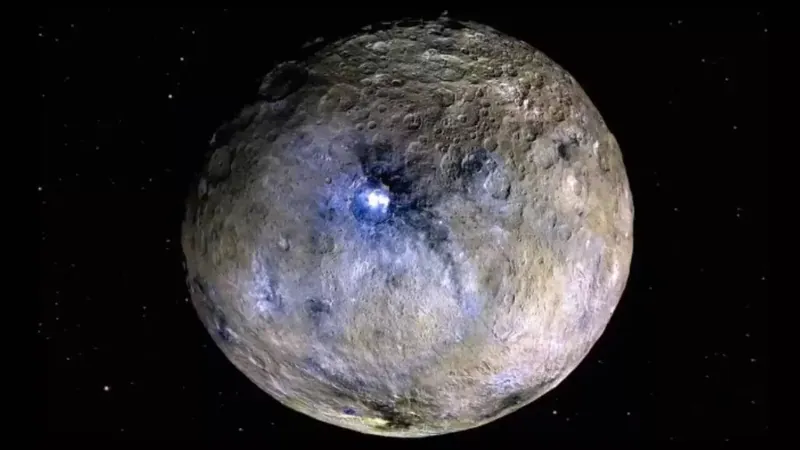
NASA's Dawn Mission Unveils a Frozen Ocean World in Our Solar System!
2025-05-22
Author: Wei Ling
An Astonishing Discovery in Our Cosmic Backyard
In the vast expanse of our solar system, countless celestial objects orbit in silence. Among these, one remarkable entity stands out: Ceres, the largest body in the asteroid belt between Mars and Jupiter. Once dismissed as a mere barren rock, Ceres is now revealing itself to be a captivating frozen ocean world, hiding extraordinary secrets just beneath its surface.
Ceres: A Hidden Ocean World Awaits
A groundbreaking study recently published in *Nature Astronomy*, fueled by data from NASA's Dawn mission, has confirmed the presence of a thick ice-rich crust beneath Ceres’ outer layer. This revelation positions Ceres as an intriguing subject for understanding ocean worlds, which were previously thought to exist only on faraway moons.
Crater Mysteries: A Clue to Ceres' Icy Nature
Scientists studying the craters on Ceres discovered startling evidence: many of these craters are remarkably preserved, showing little of the typical degradation seen on other icy bodies. This preservation suggests that the crust may be composed predominantly of water ice, inhibiting the usual relaxation process that softens crater walls over time. Researcher Pamerleau remarked, 'We used extensive Dawn observations to support our findings of a resistant ice-rich crust.' This indicates a thick, stable ice layer just below the surface.
The Dynamic Ice: Ceres' Surprising Behavior
But it’s not just about ice being frozen; Ceres' ice is dynamic. Over eons, this frozen layer can undergo solid-state flow, causing it to deform under pressure, much like glaciers on Earth. This unique behavior explains why some craters appear shallower as they age, as high stresses redistribute over time. Pamerleau noted, 'Even solids will flow over long timescales,' enhancing our understanding of Ceres’ geological age and the strength of its icy structure.
Layers of Ice and Rock: Ceres' Subsurface Secrets
Ceres' internal structure reveals a fascinating stratification. The upper layers are rich in ice, transitioning to rockier material deeper down. Co-author Sori explained, 'There’s ample water-ice near the surface, tapering off as you delve deeper.' This vertical layering bolsters the hypothesis that Ceres once harbored a subsurface ocean, which may now be a frozen reservoir, preserving vital clues about the dwarf planet's geologic and thermal history.
Ceres vs. Icy Moons: A Neighborly Advantage
The discovery of a frozen ocean positions Ceres alongside notorious icy moons like Europa and Enceladus, yet with one significant advantage: its proximity to Earth. Sori emphasized, 'The thrilling part is that we have a frozen ocean world relatively close to home.' By delving into Ceres' mysteries, scientists can refine their models of icy bodies and gain insights into how oceans can endure extreme conditions in our solar system.
A Gateway for Future Exploration!
Ceres is emerging as a prime candidate for future space missions targeting icy worlds. Its accessibility makes it an ideal prospect for missions that could drill into its crust or deploy radar to investigate its subsurface layers. As Sori put it, 'Ceres is quite possibly the most accessible icy world in the universe.' Closer examination may reveal prebiotic chemistry or even indications of microbial life, further deepening our understanding of habitability in small, frozen bodies across the cosmos.



 Brasil (PT)
Brasil (PT)
 Canada (EN)
Canada (EN)
 Chile (ES)
Chile (ES)
 Česko (CS)
Česko (CS)
 대한민국 (KO)
대한민국 (KO)
 España (ES)
España (ES)
 France (FR)
France (FR)
 Hong Kong (EN)
Hong Kong (EN)
 Italia (IT)
Italia (IT)
 日本 (JA)
日本 (JA)
 Magyarország (HU)
Magyarország (HU)
 Norge (NO)
Norge (NO)
 Polska (PL)
Polska (PL)
 Schweiz (DE)
Schweiz (DE)
 Singapore (EN)
Singapore (EN)
 Sverige (SV)
Sverige (SV)
 Suomi (FI)
Suomi (FI)
 Türkiye (TR)
Türkiye (TR)
 الإمارات العربية المتحدة (AR)
الإمارات العربية المتحدة (AR)